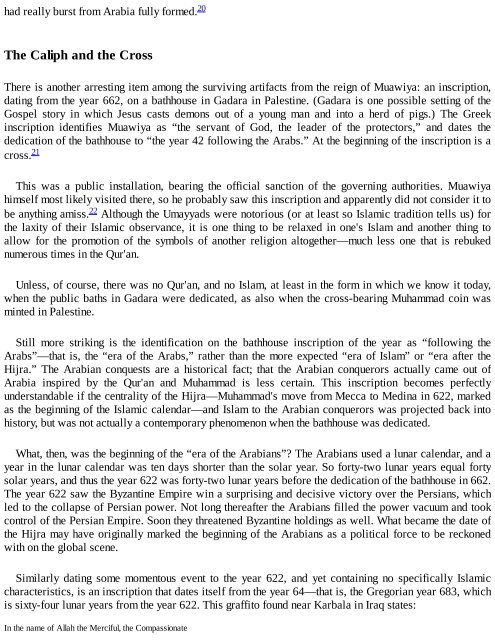robert spencer-did muhammad exist__ an inquiry into islams obscure origins-intercollegiate studies institute (2012) (1)
You also want an ePaper? Increase the reach of your titles
YUMPU automatically turns print PDFs into web optimized ePapers that Google loves.
had really burst from Arabia fully formed. 20<br />
The Caliph <strong>an</strong>d the Cross<br />
There is <strong>an</strong>other arresting item among the surviving artifacts from the reign of Muawiya: <strong>an</strong> inscription,<br />
dating from the year 662, on a bathhouse in Gadara in Palestine. (Gadara is one possible setting of the<br />
Gospel story in which Jesus casts demons out of a young m<strong>an</strong> <strong>an</strong>d <strong>into</strong> a herd of pigs.) The Greek<br />
inscription identifies Muawiya as “the serv<strong>an</strong>t of God, the leader of the protectors,” <strong>an</strong>d dates the<br />
dedication of the bathhouse to “the year 42 following the Arabs.” At the beginning of the inscription is a<br />
cross. 21<br />
This was a public installation, bearing the official s<strong>an</strong>ction of the governing authorities. Muawiya<br />
himself most likely visited there, so he probably saw this inscription <strong>an</strong>d apparently <strong>did</strong> not consider it to<br />
be <strong>an</strong>ything amiss. 22 Although the Umayyads were notorious (or at least so Islamic tradition tells us) for<br />
the laxity of their Islamic observ<strong>an</strong>ce, it is one thing to be relaxed in one's Islam <strong>an</strong>d <strong>an</strong>other thing to<br />
allow for the promotion of the symbols of <strong>an</strong>other religion altogether—much less one that is rebuked<br />
numerous times in the Qur'<strong>an</strong>.<br />
Unless, of course, there was no Qur'<strong>an</strong>, <strong>an</strong>d no Islam, at least in the form in which we know it today,<br />
when the public baths in Gadara were dedicated, as also when the cross-bearing Muhammad coin was<br />
minted in Palestine.<br />
Still more striking is the identification on the bathhouse inscription of the year as “following the<br />
Arabs”—that is, the “era of the Arabs,” rather th<strong>an</strong> the more expected “era of Islam” or “era after the<br />
Hijra.” The Arabi<strong>an</strong> conquests are a historical fact; that the Arabi<strong>an</strong> conquerors actually came out of<br />
Arabia inspired by the Qur'<strong>an</strong> <strong>an</strong>d Muhammad is less certain. This inscription becomes perfectly<br />
underst<strong>an</strong>dable if the centrality of the Hijra—Muhammad's move from Mecca to Medina in 622, marked<br />
as the beginning of the Islamic calendar—<strong>an</strong>d Islam to the Arabi<strong>an</strong> conquerors was projected back <strong>into</strong><br />
history, but was not actually a contemporary phenomenon when the bathhouse was dedicated.<br />
What, then, was the beginning of the “era of the Arabi<strong>an</strong>s”? The Arabi<strong>an</strong>s used a lunar calendar, <strong>an</strong>d a<br />
year in the lunar calendar was ten days shorter th<strong>an</strong> the solar year. So forty-two lunar years equal forty<br />
solar years, <strong>an</strong>d thus the year 622 was forty-two lunar years before the dedication of the bathhouse in 662.<br />
The year 622 saw the Byz<strong>an</strong>tine Empire win a surprising <strong>an</strong>d decisive victory over the Persi<strong>an</strong>s, which<br />
led to the collapse of Persi<strong>an</strong> power. Not long thereafter the Arabi<strong>an</strong>s filled the power vacuum <strong>an</strong>d took<br />
control of the Persi<strong>an</strong> Empire. Soon they threatened Byz<strong>an</strong>tine holdings as well. What became the date of<br />
the Hijra may have originally marked the beginning of the Arabi<strong>an</strong>s as a political force to be reckoned<br />
with on the global scene.<br />
Similarly dating some momentous event to the year 622, <strong>an</strong>d yet containing no specifically Islamic<br />
characteristics, is <strong>an</strong> inscription that dates itself from the year 64—that is, the Gregori<strong>an</strong> year 683, which<br />
is sixty-four lunar years from the year 622. This graffito found near Karbala in Iraq states:<br />
In the name of Allah the Merciful, the Compassionate


